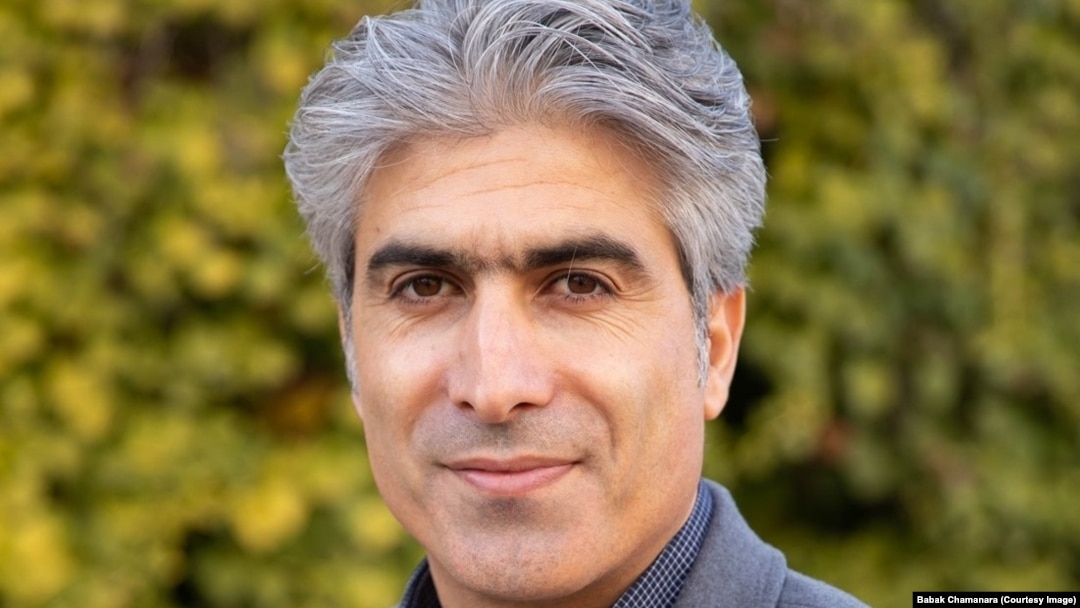Behrouz Chamanara, a language professor at Kurdistan University in western Iran, was summarily dismissed in September shortly after the local intelligence office rejected his qualifications.
Chamanara, who was detained in November 2022 and interrogated about his alleged involvement in antiestablishment protests at the university in Kurdistan Province, moved to Germany shortly after he was fired.
Speaking to RFE/RL's Radio Farda, Chamanara says that Iran's clerical establishment has tried to control universities since the 1979 Islamic Revolution. Whenever it faces public opposition, as it does today, the authorities heap pressure on universities, he says.
Through this strategy, Chamanara says, Tehran has managed to keep professors -- although not students -- in a state of relative silence.
Iran has clamped down on any sign of dissent through arrests, intrusive and high-tech surveillance, and the dismantling of student organizations and purge of professors. But while the strategy has had a palpable effect, Chamanara suggests, it will not kill the spirit of university education.
"The atmosphere at universities is extremely fragile and the government has been able to impose silence," Chamanara said. "But I believe that this situation cannot continue because universities are traditionally and historically a place to exercise freedom."
Chamanara describes a climate of fear after the authorities targeted universities amid nationwide antiestablishment protests that broke out after the September 2022 death in police custody of Mahsa Amini, a 22-year-old Kurdish-Iranian woman.
Amini's arrest for allegedly improperly wearing the hijab, and death after eyewitnesses said she was beaten in detention, led to widespread outcry among Kurds and other minorities and gave rise to the "Women, life, freedom" movement that put women's rights and anger over the draconian hijab law at the forefront.
Universities, long a bastion for opposition-minded voices in Iran, became a center for the protests early on, with female students shedding the hijab and staging sit-ins with their male counterparts calling for change.
The authorities, who initiated a brutal crackdown that led to the deaths of more than 500 demonstrators nationwide over the ensuing months, quickly stepped in to gain control at universities. Student associations were shut down, thousands of students and faculty members were disciplined or dismissed, and strict security measures were introduced over the course of a year.
Kurdistan University and other education institutions located in Amini's home province were in the thick of the protest actions and the authorities' iron-fisted response.
Chamanara, who worked in the university's Kurdish Language and Literature Department, denies that his classes were anything but academic in nature. He says the authorities nevertheless acted on fears that professors at the university were inciting students to protest.
Chamanara says he and other professors who watched the protests unfold shortly after Amini was buried in the nearby town of Saghez witnessed students being fired upon and attacked, and the university surrounded by security forces.
"We tried to calm the atmosphere," Chamanara said, but the student body had been infiltrated by the authorities to heighten tensions and cause conflict. "We saw this, we resisted, and then we were the first to be arrested because we knew what the situation was."
Chamanara was detained after he met with the university president to discuss the student protests. He says he was invited to the meeting by a member of the provincial security department and was detained shortly afterward by plainclothes officers, who insisted they just wanted to take him in for questioning.
Once in custody, he was given prison garb, his mug shot was taken, and was subjected to "white torture" -- a common practice in Iran in which inmates are held in a cell under constant bright light.
Chamanara says that over the next few days he was interrogated while blindfolded for up to 10 hours straight and was denied access to a lawyer. Everything he said was documented, he says. "They were very worried that the rest of the professors at Kurdistan University and the top professors in the country were making statements [in favor of the protests]," Chamanara said.
He was also questioned about his university education and time spent in Germany, where he earned his doctorate and holds a passport as a dual national.
Chamanara says his interrogators suggested he had gained "experiences" in Germany that were intended to be used against Iran. "They said: 'You studied there so it means that you have commitments, you work for [Germany]. We know you met a certain spy and spread all kinds of slander that derive from their fantasies.'"
After eight days, he posted bail and was released.
Following the protests, he noticed major changes at Kurdistan University. Cameras were placed at the entrances to lecture halls and classrooms, at places where teachers met, and even at the entrance to the dormitory where he and other professors lived.
Male and female professors were also segregated in common spaces, similar to steps taken to separate students at universities around the country. "It means that the atmosphere of the university is extremely suffocating," Chamanara said.
In September, the Kurdistan Intelligence Office rejected his qualifications, and his contract extension was promptly denied by the university. Believing he had no options to pursue his occupation, Chamanara left for Germany.


